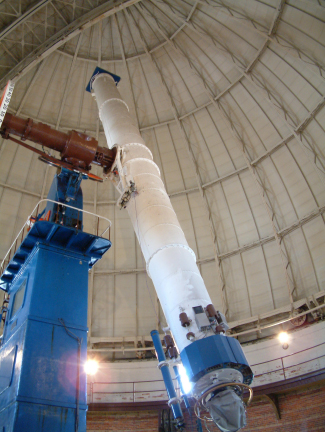4.5 Modern Observatories
Since Newton’s time, when the sizes of the mirrors in telescopes were measured in inches, reflecting telescopes have grown ever larger. In 1948, US astronomers built a telescope with a 5-meter (200-inch) diameter mirror on Palomar Mountain in Southern California. It remained the largest visible-light telescope in the world for several decades. The giants of today, however, have primary mirrors (the largest mirrors in the telescope) that are 8- to 10-metres in diameter, and larger ones are being built as shown in Figure 4.6.
Large Telescope Mirror
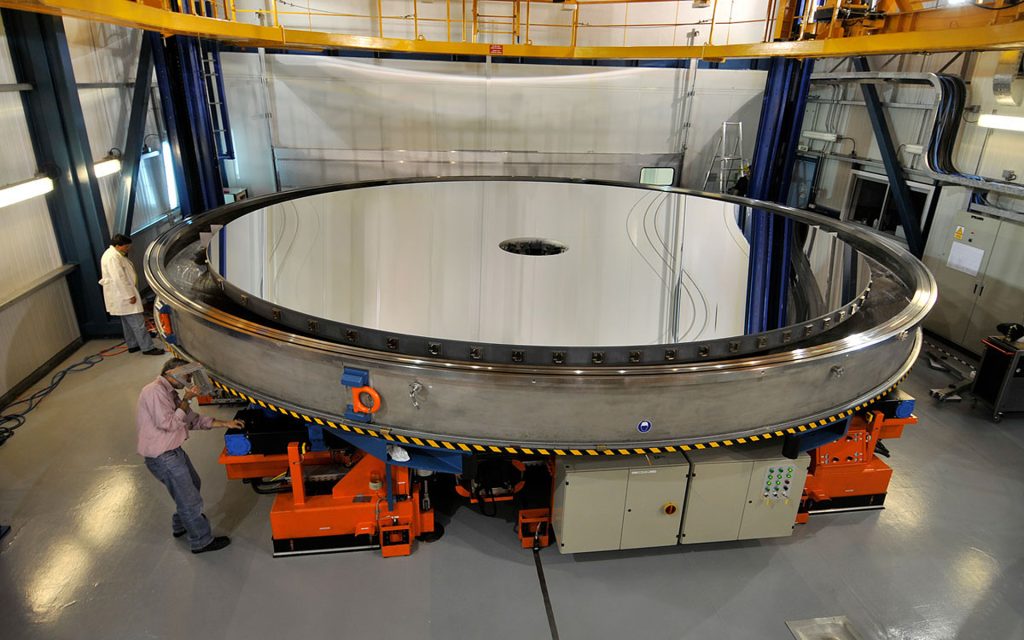
Recoating Yepun’s mirror by ESO/G. Huedepohl, CC BY 4.0.
Modern Visible-Light and Infrared Telescopes
The decades starting in 1990 saw telescope building around the globe grow at an unprecedented rate. (See Table 4.1, which also includes websites for each telescope in case you want to visit or learn more about them.) Technological advancements had finally made it possible to build telescopes significantly larger than the 5-meter telescope at Palomar at a reasonable cost. New technologies have also been designed to work well in the infrared, and not just visible, wavelengths.
| Aperture (m) | Telescope Name | Location | Status | Website |
|---|---|---|---|---|
| 39 | European Extremely Large Telescope (E-ELT) | Cerro Armazonas, Chile | First light 2025 (estimated) | www.eso.org/sci/facilities/eelt |
| 30 | Thirty-Meter Telescope (TMT) | Mauna Kea, HI | First light 2025 (estimated) | www.tmt.org |
| 24.5 | Giant Magellan Telescope (GMT) | Las Campanas Observatory, Chile | First light 2025 (estimated) | www.gmto.org |
| 11.1 × 9.9 | Southern African Large Telescope (SALT) | Sutherland, South Africa | 2005 | www.salt.ac.za |
| 10.4 | Gran Telescopio Canarias (GTC) | La Palma, Canary Islands | First light 2007 | http://www.gtc.iac.es |
| 10.0 | Keck I and II (two telescopes) | Mauna Kea, HI | Completed 1993–96 | www.keckobservatory.org |
| 9.1 | Hobby–Eberly Telescope (HET) | Mount Locke, TX | Completed 1997 | www.as.utexas.edu/mcdonald/het |
| 8.4 | Large Binocular Telescope (LBT) (two telescopes) | Mount Graham, AZ | First light 2004 | www.lbto.org |
| 8.4 | Large Synoptic Survey Telescope (LSST) | The Cerro Pachón, Chile | First light 2021 | www.lsst.org |
| 8.3 | Subaru Telescope | Mauna Kea, HI | First light 1998 | www.naoj.org |
| 8.2 | Very Large Telescope (VLT) | Cerro Paranal, Chile | All four telescopes completed 2000 | www.eso.org/public/teles-instr/paranal |
| 8.1 | Gemini North and Gemini South | Mauna Kea, HI (North) and Cerro Pachón, Chile (South) | First light 1999 (North), First light 2000 (South) | www.gemini.edu |
| 6.5 | Magellan Telescopes (two telescopes: Baade and Landon Clay) | Las Campanas, Chile | First light 2000 and 2002 | obs.carnegiescience.edu/Magellan |
| 6.5 | Multi-Mirror Telescope (MMT) | Mount Hopkins, AZ | Completed 1979 | www.mmto.org |
| 6.0 | Big Telescope Altazimuth (BTA-6) | Mount Pastukhov, Russia | Completed 1976 | w0.sao.ru/Doc-en/Telescopes/bta/descrip.html |
| 5.1 | Hale Telescope | Mount Palomar, CA | Completed 1948 | www.astro.caltech.edu/palomar/about/telescopes/hale.html |
The differences between the Palomar telescope and the modern Gemini North telescope (to take an example) are easily seen in Figure 4.7. The Palomar telescope is a massive steel structure designed to hold the 14.5-ton primary mirror with a 5-meter diameter. Glass tends to sag under its own weight; hence, a huge steel structure is needed to hold the mirror. A mirror 8 metres in diameter, the size of the Gemini North telescope, if it were built using the same technology as the Palomar telescope, would have to weigh at least eight times as much and would require an enormous steel structure to support it.
Modern Reflecting Telescopes – Hale and Gemini
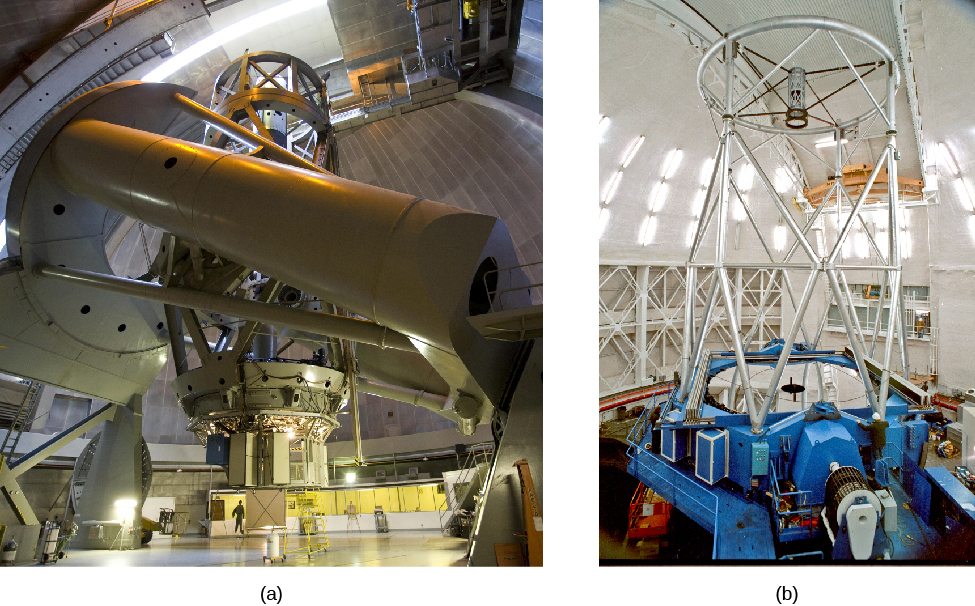
(a): Hale Telescope, Palomar Observatory by NASA/JPL, NASA Media Licence.
(b:) Gemini North Telescope by Gemini Observatory/AURA, CC BY 4.0.
The 8-meter Gemini North telescope looks like a featherweight by contrast, and indeed it is. The mirror is only about 8 inches thick and weighs 24.5 tons, less than twice as much as the Palomar mirror. The Gemini North telescope was completed about 50 years after the Palomar telescope. Engineers took advantage of new technologies to build a telescope that is much lighter in weight relative to the size of the primary mirror. The Gemini mirror does sag, but with modern computers, it is possible to measure that sag many times each second and apply forces at 120 different locations to the back of the mirror to correct the sag, a process called active control. Seventeen telescopes with mirrors 6.5 metres in diameter and larger have been constructed since 1990.
The twin 10-meter Keck telescopes on Mauna Kea, which were the first of these new-technology instruments, use precision control in an entirely novel way. Instead of a single primary mirror 10 metres in diameter, each Keck telescope achieves its larger aperture by combining the light from 36 separate hexagonal mirrors, each 1.8 metres wide as shown in Figure 4.8. Computer-controlled actuators (motors) constantly adjust these 36 mirrors so that the overall reflecting surface acts like a single mirror with just the right shape to collect and focus the light into a sharp image.
Thirty-Six Eyes Are Better Than One
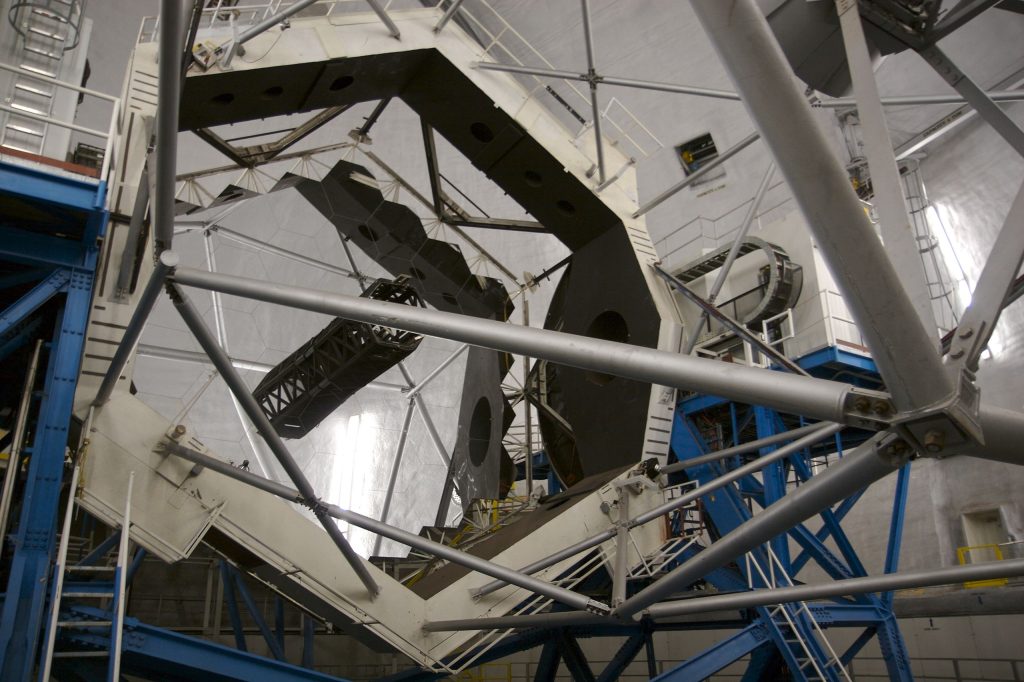
Primary Mirror of Keck Telescope by z2amiller, CC BY-SA 2.0.
In addition to holding the mirror, the steel structure of a telescope is designed so that the entire telescope can be pointed quickly toward any object in the sky. Since Earth is rotating, the telescope must have a motorized drive system that moves it very smoothly from east to west at exactly the same rate that Earth is rotating from west to east, so it can continue to point at the object being observed. All this machinery must be housed in a dome to protect the telescope from the elements. The dome has an opening in it that can be positioned in front of the telescope and moved along with it, so that the light from the objects being observed is not blocked.
George Ellery Hale: Master Telescope Builder
George Ellery Hale, shown in Figure 4.9, was a giant among early telescope builders. Not once, but four times, he initiated projects that led to the construction of what was the world’s largest telescope at the time. And he was a master at winning over wealthy benefactors to underwrite the construction of these new instruments.
George Ellery Hale (1868–1938)
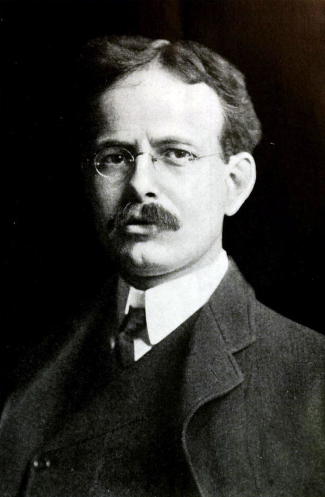
Hale’s training and early research were in solar physics. In 1892, at age 24, he was named associate professor of astral physics and director of the astronomical observatory at the University of Chicago. At the time, the largest telescope in the world was the 36-inch refractor at the Lick Observatory near San Jose, California. Taking advantage of an existing glass blank for a 40-inch telescope, Hale set out to raise money for a larger telescope than the one at Lick. One prospective donor was Charles T. Yerkes, who, among other things, ran the trolley system in Chicago.
Hale wrote to Yerkes, encouraging him to support the construction of the giant telescope by saying that “the donor could have no more enduring monument. It is certain that Mr. Lick’s name would not have been nearly so widely known today were it not for the famous observatory established as a result of his munificence.” Yerkes agreed, and the new telescope was completed in May 1897; it remains the largest refractor in the world, it is shown in Figure 4.10.
Even before the completion of the Yerkes refractor, Hale was not only dreaming of building a still larger telescope but was also taking concrete steps to achieve that goal. In the 1890s, there was a major controversy about the relative quality of refracting and reflecting telescopes. Hale realized that 40 inches was close to the maximum feasible aperture for refracting telescopes. If telescopes with significantly larger apertures were to be built, they would have to be reflecting telescopes.
Using funds borrowed from his own family, Hale set out to construct a 60-inch reflector. For a site, he left the Midwest for the much better conditions on Mount Wilson—at the time, a wilderness peak above the small city of Los Angeles. In 1904, at the age of 36, Hale received funds from the Carnegie Foundation to establish the Mount Wilson Observatory. The 60-inch mirror was placed in its mount in December 1908.
Two years earlier, in 1906, Hale had already approached John D. Hooker, who had made his fortune in hardware and steel pipe, with a proposal to build a 100-inch telescope. The technological risks were substantial. The 60-inch telescope was not yet complete, and the usefulness of large reflectors for astronomy had yet to be demonstrated. George Ellery Hale’s brother called him “the greatest gambler in the world.” Once again, Hale successfully obtained funds, and the 100-inch telescope was completed in November 1917. (It was with this telescope that Edwin Hubble was able to establish that the spiral nebulae were separate islands of stars—or galaxies—quite removed from our own Milky Way.)
Hale was not through dreaming. In 1926, he wrote an article in Harper’s Magazine about the scientific value of a still larger telescope. This article came to the attention of the Rockefeller Foundation, which granted $6 million for the construction of a 200-inch telescope. Hale died in 1938, but the 200-inch (5-meter) telescope on Palomar Mountain was dedicated 10 years later and is now named in Hale’s honour.
Picking the Best Observing Sites
A telescope like the Gemini or Keck telescope costs about $100 million to build. That kind of investment demands that the telescope be placed in the best possible site. Since the end of the nineteenth century, astronomers have realized that the best observatory sites are on mountains, far from the lights and pollution of cities. Although a number of urban observatories remain, especially in the large cities of Europe, they have become administrative centres or museums. The real action takes place far away, often on desert mountains or isolated peaks in the Atlantic and Pacific Oceans, where we find the staff’s living quarters, computers, electronic and machine shops, and of course the telescopes themselves. A large observatory today requires a supporting staff of 20 to 100 people in addition to the astronomers.
The performance of a telescope is determined not only by the size of its mirror but also by its location. Earth’s atmosphere, so vital to life, presents challenges for the observational astronomer. In at least four ways, our air imposes limitations on the usefulness of telescopes:
- The most obvious limitation is weather conditions such as clouds, wind, and rain. At the best sites, the weather is clear as much as 75% of the time.
- Even on a clear night, the atmosphere filters out a certain amount of starlight, especially in the infrared, where the absorption is due primarily to water vapour. Astronomers therefore prefer dry sites, generally found at high altitudes.
- The sky above the telescope should be dark. Near cities, the air scatters the glare from lights, producing an illumination that hides the faintest stars and limits the distances that can be probed by telescopes. (Astronomers call this effect light pollution.) Observatories are best located at least 100 miles from the nearest large city.
- Finally, the air is often unsteady; light passing through this turbulent air is disturbed, resulting in blurred star images. Astronomers call these effects “bad seeing.” When seeing is bad, images of celestial objects are distorted by the constant twisting and bending of light rays by turbulent air.
The best observatory sites are therefore high, dark, and dry. The world’s largest telescopes are found in such remote mountain locations as the Andes Mountains of Chile as shown in Figure 4.11, the desert peaks of Arizona, the Canary Islands in the Atlantic Ocean, and Mauna Kea in Hawaii, a dormant volcano with an altitude of 13,700 feet (4200 metres).
High and Dry Site
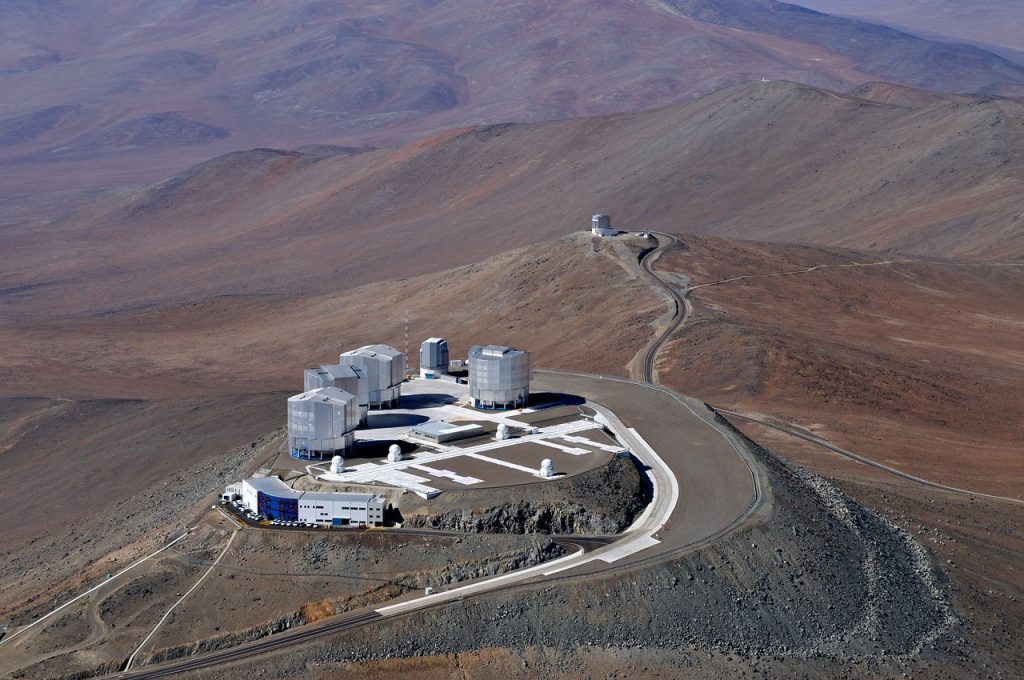
An aerial view of the Paranal Observatory in Chile by ESO/G.Hüdepohl, CC BY 4.0.
Attribution
“6.2 Telescopes Today” from Douglas College Astronomy 1105 by Douglas College Department of Physics and Astronomy, is licensed under a Creative Commons Attribution 4.0 International License, except where otherwise noted. Adapted from Astronomy 2e.

